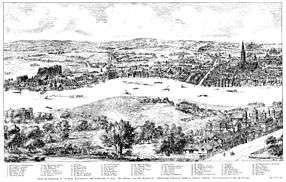Panorama of London
The city of London has long been a subject for panoramas by artists, mapmakers, and topographers. Many of their works have this as their title.
Overview
The earliest topographical drawings preceded maps according to modern definition, although they were mainly based on surveys or multiple drawings reduced to a (fairly) consistent perspective, as it is clearly impossible for them to have been produced from any single real viewpoint, unlike modern photographic panoramas. Wenceslaus Hollar's 1647 Long View of London from Bankside is an exception. Projected from a single viewpoint it resembles the perspective of a modern panoramic photograph.
Gallery
Amongst the earliest known is that drawn Wyngaerde, produced around 1543, and here shown in 19th-century printed copies.
Others include Van Visscher's of 1616:

Wenceslaus Hollar's of 1647:

Many modern panoramic photographs of London exist, from many different viewpoints:




References
External links
![]() Media related to Panoramics of London at Wikimedia Commons
Media related to Panoramics of London at Wikimedia Commons


